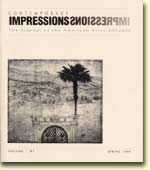![]() Home
Home
![]() The Alliance
The Alliance
![]() Exhibits
Exhibits
![]() Gallery
Gallery
![]() Resources
Resources
![]() Calendar
Calendar
![]() Competitive Exhibits
Competitive Exhibits
![]()
![]() Advocacy
Advocacy
![]() Technical Articles
Technical Articles
![]() Supplies
Supplies
![]() Links
Links
![]() Library
Library
Copyright
Information about copyright and registration forms are available on the Internet, by phone or in writing.
- Internet: http://www.loc.gov/copyright
- Phone: 202/707-3000 (this is NOT a toll-free number)
- Write: U.S. Copyright Office, Library of Congress, LM-455, Washington DC 20559-6000
Tips from the director of the American Print Alliance:
There is a registration fee for each form submitted and the fee keeps increasing, however there is now a reduced fee for online filing. The online forms require Adobe Acrobat that is at least version 8, so you can use them only on a computer with a relatively recent operating system. You can no longer download and print paper forms from the Copyright Office website, you must request that those forms be sent to you (there's a click-on from that home page). Note that the "Short Form VA" for visual arts is only a little shorter than the regular "Form VA" for visual arts, and it covers only one work — it does not allow grouping several works together for one fee. Although paper filing costs more per form, using the regular "Form VA" you can register an entire series for one fee. The series may be a formal portfolio or an informal collection of everything completed during a residency or work on a particular theme or in a particular year, for example. Be sure to ask for a continuation sheet, since there are limited spaces to list individual works on the form but you can attach as many continuation sheets as needed.
The Copyright Office often takes 6 to 8 months - or longer! - to send the official receipt, and will not provide free written confirmation about the status of applications. You can use the electronic filing system or send your application by registered or certified mail with a return receipt. Another simple way to know that your envelope has been opened and the application is in the system is to pay by check instead of money order — when the check clears, at least you know that your paperwork is there.
Copyright protection is secured automatically when an original work is created in fixed form. Since 1989 when the U.S. agreed to the Berne Convention, the use of a copyright notice is no longer required. However, placing copyright notice on your work may still be important: it informs the public that the work is protected, identifies the copyright owner, and shows the year of first publication. If the copyright notice is on your work, a defendant in a copyright infringement suit cannot claim not to have known that the work was protected.
Copyright registration adds certain advantages. Before an infringement suit may be filed in court, the work must be registered. If registration is made within 5 years of publication, the registration establishes prima facie evidence in court of the validity of the copyright and of the facts stated in the certificate. If registration is made within 3 months of publication or prior to the infringement, statutory damages and attorney's fees will be available to the copyright owner in court actions. (Otherwise, the most the copyright owner could receive is an award of actual damages and profits.)
ONLY copyright registration gives you these specific legal rights and protections. Some commercial services are now offering artists the "opportunity" to register their names (and titles of their works) with the company for a nominal fee — seemingly less than the copyright registration. However, all that does is put your name in a private company's list. It gives you NO legal rights and NO governmental protection. And it costs more than registering your work in a group for actual copyright protection, since you can register dozens of individual works in one group with one fee.
Please remember that the Alliance cannot provide legal advice or legal services. Much more information is available from the Copyright Office; the following circulars are especially useful for printmakers and are accessible from the Library of Congress Internet site:
If you have any questions about copyright, don't hesitate to ask the Copyright Office and/or consult an attorney who specializes in intellectual property rights.
